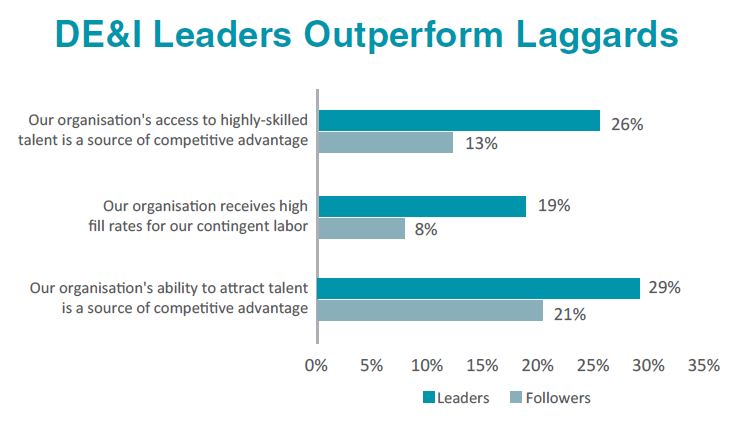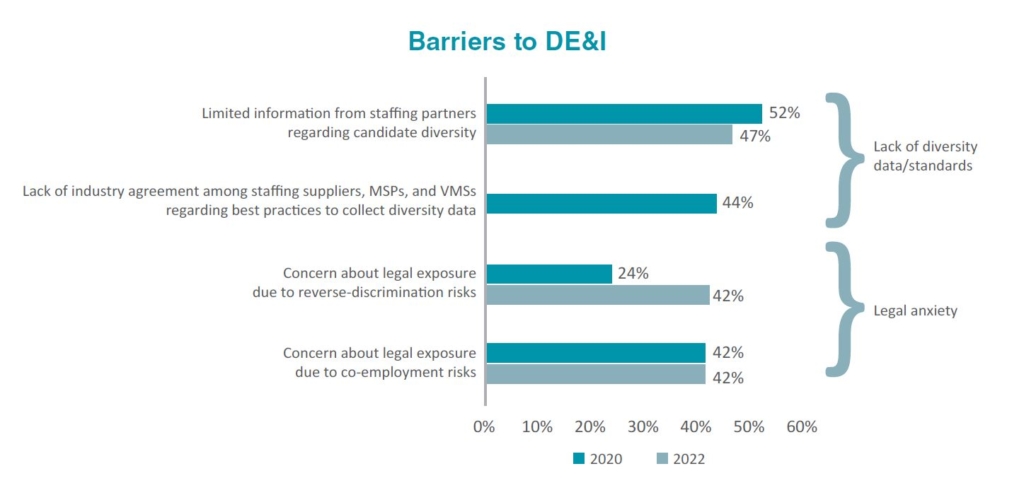From a business perspective, workplace diversity, equity and inclusion is not just a moral objective to pursue — it can also provide a strategic and financial advantage. Research studies from SIA show that organisations that embrace a culture of diversity, equity and inclusion thrive, while those that do not are consistently disadvantaged.
Data from Global Diversity Practice, a diversity consultant firm, indicate that businesses with a healthy balance of men and women are 21% more likely to outperform their competitors. When considering ethnicity, this increases to 33%. Teams that are diverse in gender, age and ethnicity make better decisions up to 87% of the time.
SIA surveyed more than 250 business leaders from the US, Europe and APAC for its “Future of Diversity, Equity, and Inclusion in Contingent Workforce: 2022 Update” report. According to the report, DE&I leaders in 2022 outperform followers in areas such as access, fill rates and ability to attract talent — providing a significant competitive advantage in today’s tight labour markets.
Despite this, there remain identifiable barriers to accelerating contingent DE&I. The research indicates that the top two obstacles when comparing leaders versus followers in their efforts in this space are data related.
When we questioned followers regarding their top barriers to DE&I, nearly half of respondents, 47%, stated their primary obstacle was limited information from staffing partners regarding candidate diversity. This was followed with 44% of participants stating there is a lack of agreement among staffing suppliers, MSPs and VMSs regarding best practices to collect diversity data.
The second tranche of obstacles are centered on legal issues and are closely related to the aforementioned barriers concerning data collection. Forty-two percent of respondents are concerned with legal exposure due to reverse discrimination risk, up from 24% in 2020, with the same proportion concerned about legal exposure due to co-employment risks as well as the concern regarding legal exposure due to employment risks.
The old adage “you can’t manage what you can’t measure” may be true here; evidence exists that data metrics analysis and KPIs are perhaps providing leaders that competitive advantage. Since the 2020 survey, leaders now collect 20% more DE&I key performance indicators, with the marketplace investing significantly in this area. An area that saw the highest increase in KPI usage was supplier outreach to source diverse candidates, with 37% in 2022, a 13-percentage-point increase since the last survey. Monitoring diverse candidates within the supplier’s pool also saw an increase — rising 10 percentage points to 29%. However, in first place with an overwhelming majority was tracking suppliers’ diversity ownership status, with 61% of respondents doing so.
When asked about KPIs and metrics in DE&I initiatives for contingent workers, leaders saw a 14-point increase regarding benchmarked DE&I data versus their competitors, rising to 31%; they also tend to track more fill rate data than previously, an increase of 11 percentage points. A shift in mindset can also be delineated, as we see an increase in the use of survey satisfaction results among contingent workers, which is up 10 points to 29% since 2020.
The access to DE&I data is looking like a game changer when it comes to the strategy, monitoring and success of a diversity program. The industry has historically focused on supplier diversity, which is a valid and essential part of a company’s diversity strategy.
However, today’s reality is that even having a diverse set of suppliers — woman-owned, minority-owned, disabled veteran-owned — will not necessarily ensure that the talent they supply is diverse.
With VMS use by large companies an almost ubiquitous part of processing contingent labour (81% of firms with over 1,000 employees in the Americas had a VMS in place, according to SIA’s 2022 Workforce Solutions Buyer Survey), VMS is now emerging as a promising partner in how companies might facilitate DE&I in their contingent workforce programs. VMSs are equipped to collect, store, manage and analyse large amounts of data related to contingent workers, including diversity data that client organisations might use to obtain deeper and broader insights into DE&I and eventually utilise to steer DE&I decisions, strategy and culture within organisations.
Robust DE&I data could tip the scales for many companies in their efforts to accelerate DE&I and could change the game greatly for how companies think and behave with respect to diversity, equity and inclusion. Over the past year, many VMSs have enhanced their offerings to prevent bias at the hiring stage, help build and encourage diverse talent communities and provide actionable insights on diversity using analytics.
One of the challenges in tracking diversity data from staffing organisations is not getting the diversity information directly from the source. That often creates challenges and data discrepancies when multiple sources give you conflicting information on the same candidate. Many of the VMSs are solving this issue by providing functionality that enables the applicant to directly provide the information in a secure manner once the staffing partner submits the candidate.
Unsurprisingly, 83% of contingent workforce managers indicated that they would seriously explore or are already exploring VMS-derived diversity data. The realisation of this would be game-changing, enabling companies to make strides in measuring diversity, equity and inclusion and take the next steps to increase belonging and enhance program performance.
Given the thirst for knowledge, data and advice around DE&I issues, organisations have never been more open to receiving help and support from their partners in the workforce solutions ecosystem. While progress may be slower than feared, it is clear that organisations must collaborate with multiple stakeholders to overcome DE&I challenges.









